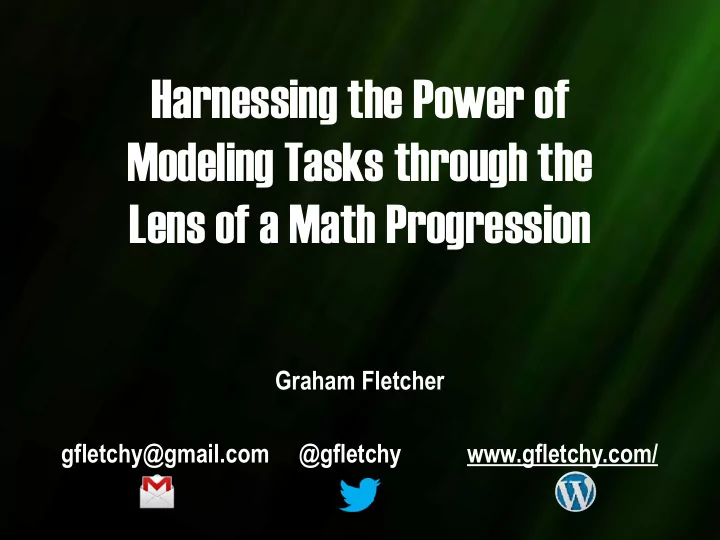

Harnessing the Power of Modeling Tasks through the Lens of a Math Progression Graham Fletcher gfletchy@gmail.com @gfletchy www.gfletchy.com/
Procedural Conceptual Fluency Understanding Application http://www.corestandards.org/other-resources/key-shifts-in-mathematics/
Procedural Conceptual Fluency Understanding Application
Procedural Conceptual Fluency Understanding Application http://www.corestandards.org/other-resources/key-shifts-in-mathematics/
3 students doing the solving and the sense making teacher showing a very conceptual approach top-down, rule oriented approach Instructor’s Manual for Elementary and Middle School Mathema7cs Teaching Developmentally Sixth Edi7on - John A. Van de Walle (Virginia Commonwealth University)
? 3 questions
? 1 Billion Circles
? 100 circles : minute 144,000 circles : day 1,000,000,000 would take 6944 days 19+ years with no sleep
? 2nd Question
Where does 1 billion go on the number line? 0 1 trillion
Where does 1 billion go on the number line? 0 1 trillion
5 6 x 8
6 x 5 8
Today’s Goals • Understand the structure of 3-act task and see how they fit into the scope and sequence of a unit. • Explore the importance of progressional understanding and how a good task can be used as formative assessment. • Numbers and Operations in Fractions • Understand the importance of an effective closing and the role it plays in deciding our next move.
How many orange wedges are in the bowl? Estimate
? How many orange wedges are in the bowl? What information do you need to know?
Each orange wedges is a quarter.
Graham had 5 oranges and cut them into quarters. How many orange wedges did Graham have?
3-Act Tasks Act 1: • Real world problem or scenario presented • What do you notice? What do you wonder? • Make estimates Act 2: • Identify missing variables and missing variables to solve • Define solution path using variables Act 3: • Solve and interpret results of the solution • Validate answer
Most asked questions: • How often should we use 3-Act Tasks? How do they fit into the scope of a unit? • How long does one task usually take? • What if we don’t have the time?
MTMS: Vol. 14, No. 9, May 2009-5 Prac7ces for Orchestra7ng Produc7ve Mathema7cs Discussions
5 The practices are: 1. Anticipating student responses to challenging mathematical tasks; 2. Monitoring students’ work on and engagement with the tasks; 3. Selecting particular students to present their mathematical work; 4. Sequencing the student responses that will be displayed in a specific order and; 5. C onnecting different students’ responses and connecting the responses to key mathematical ideas. MTMS: Vol. 14, No. 9, May 2009-5 Prac7ces for Orchestra7ng Produc7ve Mathema7cs Discussions
? 5 oranges Each wedge is a quarter
5 The practices are: 1. Anticipating student responses to challenging mathematical tasks; 2. Monitoring students’ work on and engagement with the tasks; 3. Selecting particular students to present their mathematical work; 4. Sequencing the student responses that will be displayed in a specific order and; 5. C onnecting different students’ responses and connecting the responses to key mathematical ideas. MTMS: Vol. 14, No. 9, May 2009-5 Prac7ces for Orchestra7ng Produc7ve Mathema7cs Discussions
1b-Counting Up 1a-Counting Up
2b-Skip Counting 2a-Skip Counting 1b-Counting Up 1-Counting Up
2b-Skip Counting 3a-Multiplicative 2a-Skip Counting 3b-Multiplicative 1b-Counting Up 1-Counting Up
2b-Skip Counting 3a-Multiplicative 2a-Skip Counting 3b-Multiplicative 1b-Counting Up 1-Counting Up
Group 1 Group 3 Group 2
Unit Fractions
Representation of a Fraction 1 unit fraction — a
Say this fraction 3 4
Say this fraction 3 4 three one-fourths
3 = 1 + 1 + 1
3 = 1 + 1 + 1 3 1 1 1 = + + 4 4 4 4
What’s the Sum?
What’s the Sum?
What’s the Sum?
Open Middle CCSS.MATH.CONTENT.4.NF.A.2 Directions: Using the whole numbers 1-9 once each, create and place 4 fractions greater than 1 on the number line in the correct order. (fractions B & C are equal) D A B C
Equivalent Fractions
E q ual F raction 2 3 = = 3 4 2 = 6
W T F ?
W T F ? hat’s his raction
It is possible to over-emphasize the importance of simplifying fractions in this way. There is no mathematical reason why fractions must be written in simplified form, although it may be convenient to do so in some cases. http://commoncoretools.me/wp-content/uploads/2011/08/ccss_progression_nf_35_2013_09_19.pdf
? What about “the test”
3 1 6 + is equal to which of the following? 6 4 a. 12 8 b. 12 3 c. 6 d. None of the above
Simplifying Equivalence
Comparing Fractions
? Which girl ate more apple?
? Which girl ate more apple? What information do you need to know? Pause I I
Pause I I twelfths eighths
Apple Eat Off Act-3
10 Big sister ate of an apple and little sister ate 12 7 of an apple. Which sister ate more apple? 8
5 The practices are: 1. Anticipating student responses to challenging mathematical tasks; 2. Monitoring students’ work on and engagement with the tasks; 3. Selecting particular students to present their mathematical work; 4. Sequencing the student responses that will be displayed in a specific order and; 5. C onnecting different students’ responses and connecting the responses to key mathematical ideas. MTMS: Vol. 14, No. 9, May 2009-5 Prac7ces for Orchestra7ng Produc7ve Mathema7cs Discussions
S1 S2 Pause S4 I I S3 S6 S5
S3 S4 S1
3 It Takes 3 to Prove it to Me
Recommend
More recommend